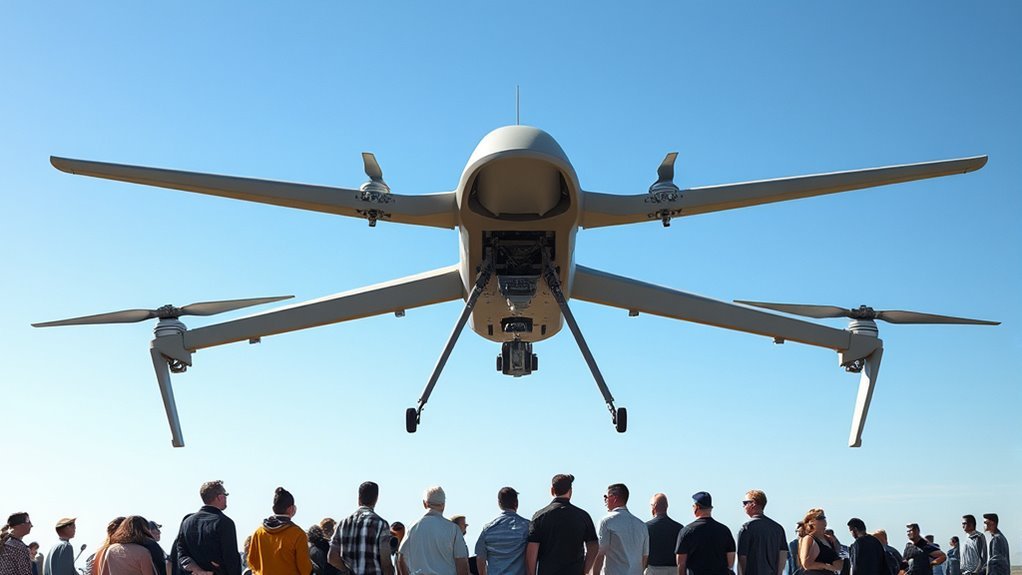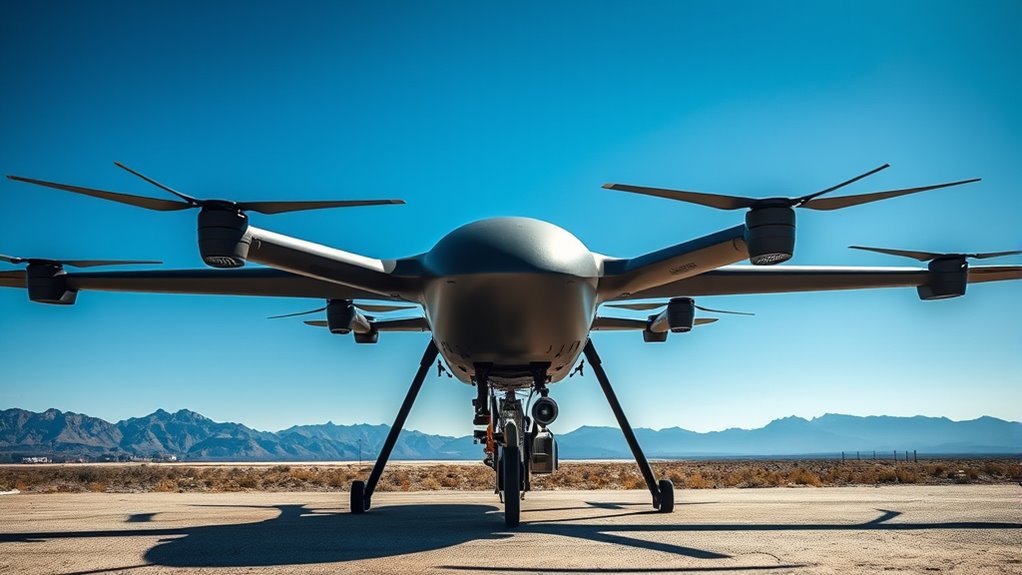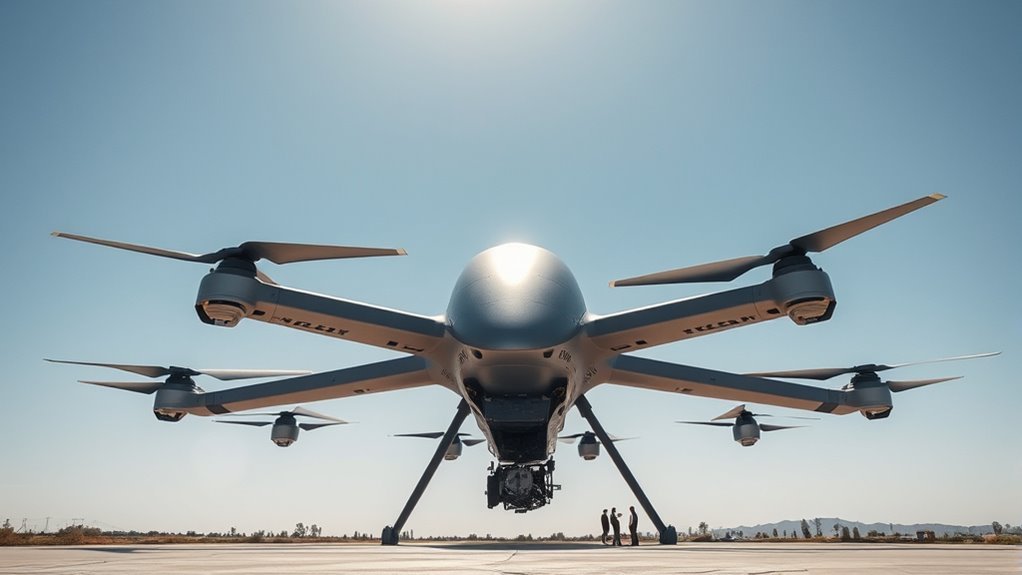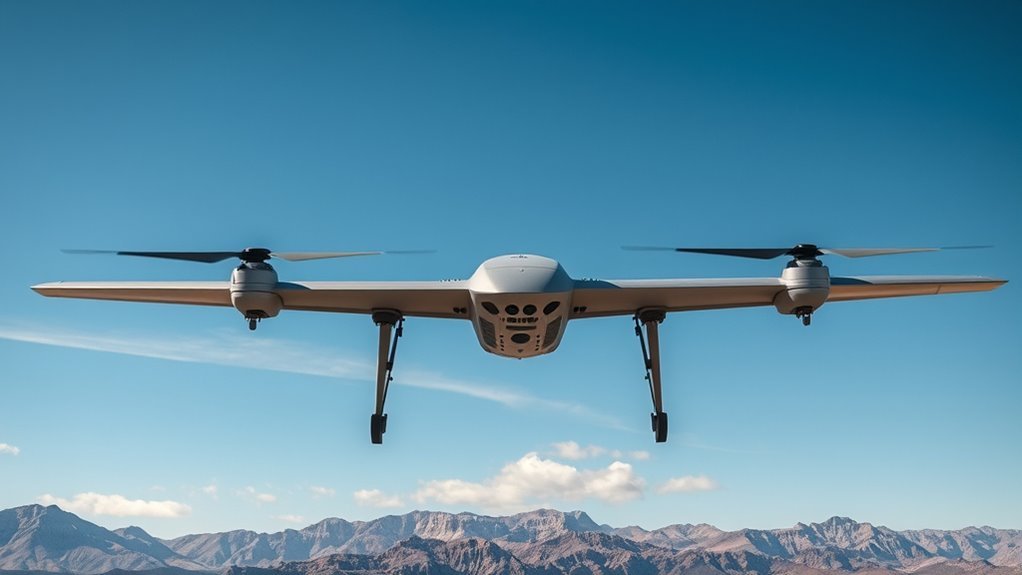The biggest drone in the world features a wingspan that exceeds 100 feet and a payload capacity of over 2,000 pounds, revolutionizing multiple industries. Its advanced technology allows for long flight times exceeding 30 hours and enhances aerial photography, surveillance, and data collection. Built with lightweight materials and cutting-edge engineering, it’s designed for both stability and efficiency. Discover how this engineering marvel applies to various fields and its potential future innovations as you explore further.
Overview of the Largest Drone

When it comes to aerial innovation, the largest drone in the world stands as a remarkable demonstration of engineering prowess. This colossal machine isn’t just about size; it showcases advanced technology that pushes the boundaries of what’s possible in unmanned flight. With its ability to carry substantial payloads, it becomes a game-changer for industries like aerial photography, where capturing stunning visuals from above is paramount. However, it’s essential to navigate the complex landscape of drone regulations that govern its use. Understanding these regulations guarantees you can operate this impressive drone responsibly while revealing the freedom to explore and document the world from a unique perspective. Embracing this technology opens doors to new possibilities in both creativity and functionality.
Key Features and Specifications

As you explore the key features and specifications of the largest drone in the world, you’ll discover an impressive array of capabilities that set it apart from its competitors. This drone not only pushes the boundaries of technology but also adheres to stringent drone regulations for peak flight safety. Here are some standout features:
- Wingspan: With a massive wingspan exceeding 100 feet, it offers unmatched lift and stability.
- Payload Capacity: It can carry payloads of over 2,000 pounds, making it ideal for various applications.
- Endurance: Flight times can exceed 30 hours, allowing for extensive missions without refueling.
- Advanced Sensors: Equipped with high-definition imaging and real-time data collection capabilities, it enhances operational efficiency.
These specifications highlight its dominance in the drone landscape.
Design and Engineering Marvel

The largest drone in the world stands as a demonstration to cutting-edge design and engineering prowess. It boasts striking drone aesthetics, blending form and function seamlessly. You might be amazed at how engineers tackled numerous engineering challenges, from optimizing aerodynamics to maximizing payload capacity. Every curve and angle is meticulously crafted to enhance performance while maintaining visual appeal. Advanced materials, like lightweight composites, guarantee strength without compromising efficiency. As you explore deeper, you’ll appreciate the intricate systems that allow for stability and precision in flight. This drone isn’t just a marvel of technology; it’s a reflection of human ingenuity and the relentless pursuit of freedom in the skies. Its design sparks inspiration for future innovations, pushing boundaries further.
Applications Across Various Industries
As you explore the potential of the biggest drone in the world, you’ll find its versatility spans several critical industries. In agriculture, it enhances crop management through precision monitoring, while in military and defense, it offers strategic advantages for surveillance and operations. Additionally, its role in infrastructure inspection guarantees safety and efficiency, redefining how we maintain essential assets. Furthermore, its advanced monitoring capabilities allow for real-time data analytics, ensuring timely interventions and optimized resource use in agricultural practices. This is especially important for resource management to minimize waste and enhance operational efficiency.
Agriculture and Crop Management
Drones are revolutionizing agriculture and crop management, offering farmers innovative solutions to enhance productivity and sustainability. They enable you to monitor your crops from above, optimizing growth and resource use. Here are some key applications:
- Crop Monitoring: Drones provide real-time data on crop health, helping you make informed decisions.
- Aerial Spraying: Efficiently apply fertilizers and pesticides, reducing labor costs and minimizing chemical waste.
- Soil Analysis: Drones can assess soil conditions, allowing for tailored planting strategies.
- Irrigation Management: Identify areas needing water, improving efficiency and conserving resources.
Military and Defense Operations
In addition to their role in agriculture, drones have become indispensable tools in military and defense operations, offering capabilities that enhance situational awareness and operational efficiency. With advancements in drone warfare, you can leverage real-time intelligence, enabling precise targeting and minimizing collateral damage. These unmanned systems provide tactical advantages, like surveillance from high altitudes and the ability to operate in hostile environments without risking personnel. Drones can conduct reconnaissance missions, gather actionable data, and even deliver payloads, transforming modern combat dynamics. As you consider the implications of drone technology, recognize its potential to redefine defense strategies while promoting freedom by reducing the need for ground troops in dangerous zones. Embracing this innovation could lead to safer, more effective military operations.
Infrastructure Inspection and Maintenance
The integration of drones into infrastructure inspection and maintenance has revolutionized how industries monitor and manage their assets. You’ll find drone inspections offer significant advantages over traditional methods, especially when addressing maintenance challenges. Here’s how they’re making a difference:
- Safety Enhancement: Drones minimize human risk by accessing hazardous areas.
- Cost Efficiency: They reduce the time and labor required for inspections.
- Data Accuracy: Equipped with high-resolution cameras, drones provide precise data for better decision-making.
- Real-time Monitoring: Drones allow for immediate assessments, enabling faster response to potential issues.
Comparison With Other Notable Drones
While comparing the largest drone in the world to other notable models, it’s essential to take into account not only size but also capabilities and intended applications. The differences in design often reflect varying drone regulations and ethical considerations. Additionally, advancements in cutting-edge innovation have significantly influenced the capabilities of modern drones, enabling them to perform tasks more efficiently.
| Drone Model | Payload Capacity | Primary Use |
|---|---|---|
| Largest Drone | 2500 kg | Cargo transport |
| DJI Matrice 600 | 6 kg | Aerial photography |
| General Atomics MQ-9 | 1,750 kg | Military surveillance |
Each drone serves unique purposes, from commercial deliveries to military operations. Understanding these distinctions helps you appreciate how drone technology is evolving, while also highlighting the importance of adhering to drone regulations and ethical considerations in their deployment. Additionally, the inspection capabilities of various drones, such as the Intel Falcon 8+ and DJI Matrice 300 RTK, demonstrate how advancements in technology are reshaping operational efficiency.
Impact on Aerial Surveillance and Data Collection
As aerial surveillance technology continues to advance, the integration of the largest drone in the world considerably enhances data collection capabilities across various sectors. You’ll find that improved data accuracy transforms operations in ways that were previously unimaginable. Here are four key impacts:
- Real-time Monitoring: Drones can provide live feeds, enabling immediate decision-making.
- High-resolution Imaging: Advanced cameras capture detail that enhances analysis.
- Broader Coverage: They can survey vast areas quickly, reducing time and labor costs.
- Data Integration: Collected data can be seamlessly combined with other systems for thorough insights.
Additionally, the use of real-time data processing features allows for instantaneous analysis of drone feeds, further enhancing operational efficiency.
These advancements not only contribute to more effective surveillance technology but also promote a greater sense of autonomy in data-driven decision-making.
Future Developments in Drone Technology
As you explore the future of drone technology, you’ll notice a significant shift towards autonomous flight advancements that promise to revolutionize aerial operations. Enhanced payload capacities are also on the horizon, enabling drones to carry heavier and more diverse equipment. Together, these developments could redefine the capabilities and applications of drones in various industries. Additionally, the integration of autonomous flight systems will enhance operational safety and efficiency, making drones even more viable for urban mobility solutions. These innovations, driven by AI algorithms, will ensure that drones can navigate complex environments with precision and reliability.
Autonomous Flight Advancements
Although the domain of drone technology has already seen remarkable innovations, the future of autonomous flight promises even more transformative advancements that could redefine industries. You’ll witness significant changes driven by enhanced autonomous navigation and sophisticated flight algorithms.
Consider these key advancements:
- Improved Decision-Making: Drones will utilize advanced AI to process data in real-time, making autonomous decisions based on environmental factors.
- Swarm Technology: Groups of drones will collaborate seamlessly, executing complex missions collectively.
- Enhanced Safety Protocols: Autonomous systems will feature robust fail-safes, minimizing risks during operations.
- Expanded Operational Range: Drones will cover longer distances independently, allowing for more extensive applications in various sectors.
These developments could reveal new potentials, giving you the freedom to explore uncharted territories.
Enhanced Payload Capacities
While advancements in drone technology continue to reshape industries, enhancing payload capacities stands out as a critical development that could revolutionize logistics, agriculture, and emergency response. By focusing on payload optimization, manufacturers are pushing the boundaries of what drones can carry. Imagine a drone equipped with heavy lift capabilities, capable of transporting medical supplies to remote areas or delivering critical goods in disaster-stricken zones. This evolution not only increases efficiency but also offers unprecedented freedom for businesses and communities. As drones become capable of handling larger loads, the potential applications will expand, allowing you to harness technology for greater impact. The future of drone technology promises more than just flight; it offers a new era of resource distribution and accessibility.
The Role of Large Drones in Environmental Conservation
Large drones have emerged as vital tools in environmental conservation, enabling researchers and organizations to monitor ecosystems with unprecedented efficiency and accuracy. These powerful devices are revolutionizing how we approach wildlife monitoring and habitat restoration. Here are four key roles they play:
Large drones are transforming environmental conservation, enhancing wildlife monitoring and habitat restoration with unmatched precision and efficiency.
- Wildlife Monitoring: Large drones can survey vast areas, collecting data on animal populations and movements without disturbing them.
- Habitat Restoration: They assist in identifying degraded areas and evaluating the success of restoration efforts.
- Data Collection: Drones gather high-resolution imagery and environmental data, essential for informed decision-making.
- Pollution Tracking: They help detect and monitor pollution sources, contributing to cleaner ecosystems.
With these capabilities, large drones empower you to protect and preserve our planet’s natural resources more effectively.
Frequently Asked Questions
What Is the Price Range for the Largest Drone?
When you explore price comparisons for large drones, you’ll notice market trends fluctuate considerably. Costs can range from tens of thousands to millions, reflecting advanced technology and capabilities that cater to diverse needs and applications.
How Does Weather Affect Large Drone Operations?
Weather conditions greatly impact drone performance. Strong winds, rain, or snow can hinder flight stability and control, affecting payload delivery and operational safety. Understanding these factors helps you optimize your drone’s efficiency in various environments.
Are There Any Regulations for Flying Big Drones?
Yes, there’re drone regulations in place that impose flight restrictions based on size and purpose. You’ll need to familiarize yourself with local laws to guarantee safe, compliant operations while enjoying the freedom of flying big drones.
What Are the Maintenance Costs for Large Drones?
When considering large drones, you’ll find that drone upkeep can be costly. Maintenance challenges often arise from intricate systems, requiring regular inspections and repairs, which can add considerably to overall operational expenses.
Can the Largest Drone Be Used for Recreational Purposes?
While large drones can offer immense recreational benefits, their size often limits safe, casual use. You’ll need to contemplate drone safety regulations and practicalities before taking one for a leisurely flight in open spaces.

